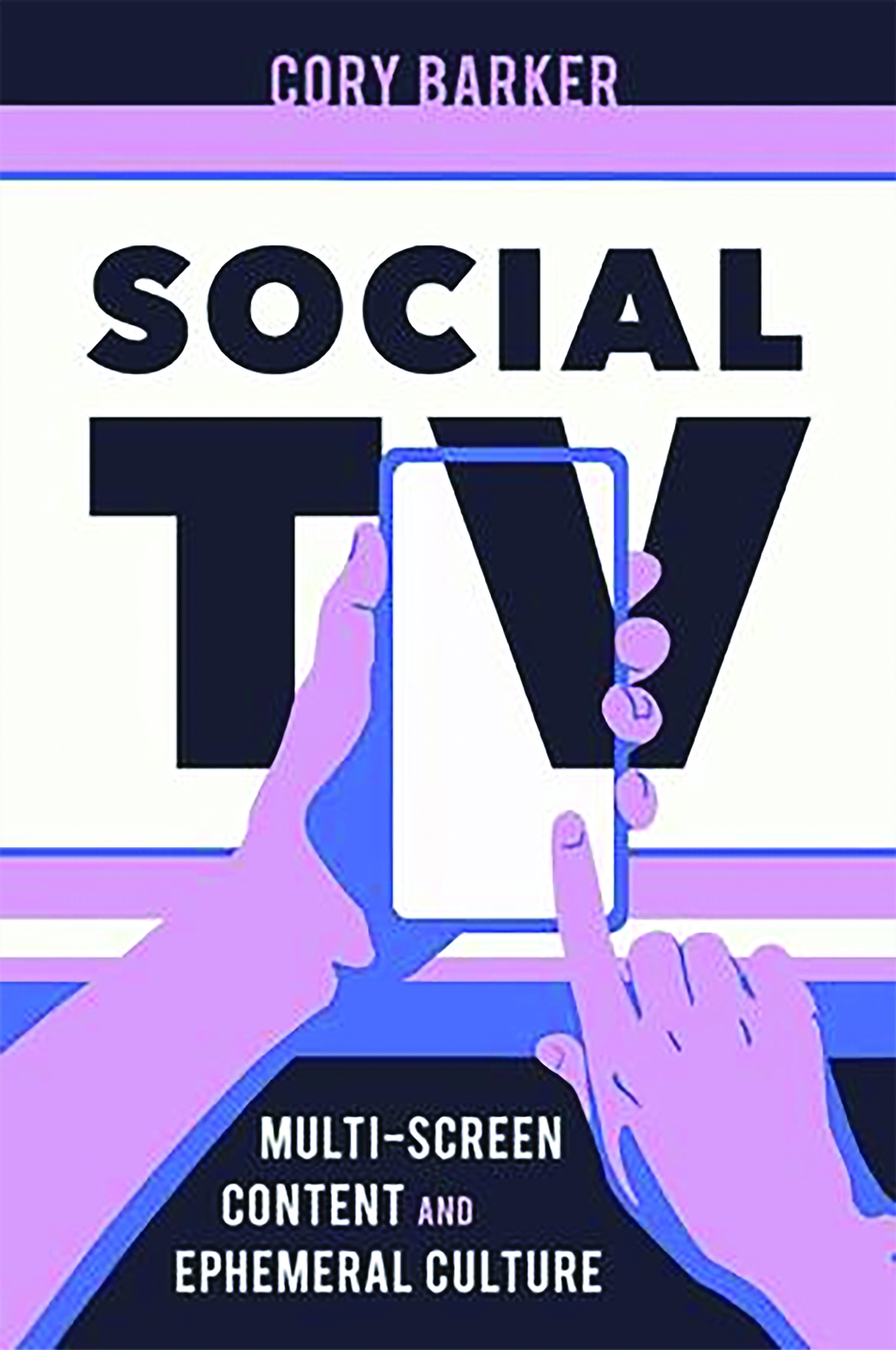Throughout the 2010s, media industry stalwarts and newcomers experimented with ways that audiences engaged digitally with televised content through social media, branded smartphone apps, and crowdsourcing campaigns. Cory Barker’s Social TV: Multi-Screen Content and Ephemeral Culture groups these media experiences under the term “social TV,” broadly defined as the “intersections between social platforms and television” but further explained as the industry strategies employed in these experiments, the platforms utilized or developed as part of these strategies, the lived experiences of consumers with these platforms, and the discourse developed about and through these experiments.1 Many cases of social TV fruitlessly sought to re-center the live experience of American television consumption to counteract the shrinking audience of linear television. These cases often failed, are no longer accessible, and have been forgotten as discursively hyped practices by media industries for both scholars and journalists. Barker therefore overcomes a daunting challenge in examining how these ephemeral objects were both experienced by fans and utilized for strategic political and economic purposes by media industries. Social TV offers important historical and cultural insights into an uncertain period in the television industry that will particularly interest television studies scholars, media industry scholars, and fan studies scholars.
To overcome the ephemeral nature of his archive, Barker employs ephemeral historiography, or the “analysis of the once hyped but eventually failed, temporary, or discarded.”2 This approach harkens back to earlier eras of media history research, when media archives were generally less accessible to researchers because of the lack of an archive. Barker overcomes this challenge masterfully, drawing on a mix of trade publications, publicity materials, interviews with industry workers, and personal experience to fill out the archive examined throughout Social TV. In overcoming this challenge, Barker offers historically useful insights about how media practices emerge in media industries.
Barker’s biggest contribution to Social TV is his idea of the remediation–legitimation cycle, “where new technology is positioned to remediate an old medium like television into a more interactive, communal, and democratic entity, only to be subsumed into legitimate (e.g., typical, revenue-generating) practices.”3 This cycle examines how new media technologies are experimentally deployed to “update” older media technologies for specific strategic purposes. If the old technology is successfully remediated through the new technology, it is legitimated as a new cultural norm surrounding the media or subsumed into another legitimate practice. This theoretical contribution fits within a strong line of media industries research that considers media practices, discourse around those practices, and audience responses to those practices as iteratively reconstructing the industry to adapt to new competitors.4 While many of the specific examples of social TV that Barker examines throughout the book were subsumed into other experiments with social TV or pre-legitimated business practices, other cases were abandoned, left as commercial failures by the media businesses that attempted them. Barker usefully notes that “cycles of remediation-legitimation do not occur linearly,”5 instead functioning as continuous industrial experiments where practices and technologies are tested before becoming legitimated or abandoned. The range of objects examined in social TV therefore examines a broad array of practices and technologies, some of which were subsumed into other industry practices, some of which are still commonly employed (albeit with varying success), and some of which were abandoned entirely.
Chapters two, four, and six showcase ephemeral social content that has been either adopted or continually experimented with by the television industry. Chapter two’s examination of ABC’s “Thank God It’s Thursday” hashtag campaign provides a useful example of a social TV strategy that was not subsumed into a more legitimate form of televisual practice but instead was adopted as a semi-standard industry practice still employed by linear television players. Barker examines how the ABC networks, Shonda Rhimes, and actors in Rhimes’ shows strategically coordinated participation on Twitter to foster audience discourse about the Thursday night line-up of Shondaland shows on ABC. In doing so, ABC sought to make “Thank God It’s Thursday” an event that required live viewing, thus raising ratings for the programs and attracting advertisers. Additionally, this examination of ABC’s social campaign highlights how television branding is constructed hierarchically through a range of constituents, including networks, creators, talent, and fans.6 Barker usefully builds on this brand theory, showcasing how television brands have thoughtfully cultivated practices of fandom that circulate on social media in order to broaden the reach and appeal of shows and dayparts. Chapter six similarly details how HBO used social media to generate interest in their brand through hierarchical social media branding. Distinct from more common social media practices like generating audience discourse on social media, chapter four examines television check-in services GetGlue, Miso, and Viggle as offering user engagement that falls between active fan production and fan consumption. Users would check in when watching live TV to earn varying rewards, like badges, that could be used as forms of cultural capital in fandoms surrounding shows while also encouraging audiences to watch the televised programs live. Although these apps did offer unique rewards, many of the benefits driven by the “reward economy” of these apps function similarly to the social productivity seen in current apps like Letterboxd, TVTime, and Rotten Tomatoes. The types of fan practices offered by currently prominent check-in sites and review sites continue to be employed as ways of generating word-of-mouth fervor for media industries. For instance, Rotten Tomatoes audience scores are commonly co-opted in digital advertising campaigns for newly released movies. These chapters about legitimated social television therefore offer useful theorizations of how meaning and value are constructed between fans and media industries through the sociality surrounding television and provide instructive histories of ongoing industry practices at the same time.
While chapters two, four, and six focus on industry practices that have continued to be employed or have evolved, chapters three and five examine experiments that were altogether abandoned by brands. Chapter three focuses on how corporations experimented with interactive second-screen experiences for audiences in order to drive the live consumption of linear television. Barker describes AMC’s StorySync, a short-lived app that, through a second screen, “dispensed narrative context through flashbacks … or similar events from a program’s source material” as well as “asked viewers to engage in playful predictions and trivia contests connected to the on-screen action, … only available to those willing to watch episodes – as well as commercials – during the live broadcast.”7 By examining AMC’s use of StorySync with The Walking Dead, Barker demonstrates how the show sought prestige TV status through the app’s paratexts. The extra content provided through StorySync supplemented the television series in a way that legitimated it as distinctive from other types of television that did not need this type of complex, multi-screen engagement. Such practices of televisual distinction and legitimation fall into a long lineage of the strategic use of paratexts.8 However, Barker’s focus on StorySync offers insights into how paratexts can often serve multiple purposes. Beyond legitimating the program and offering deeper fan engagement, Barker thoughtfully notes how this ephemera sought to discipline live viewing practices in the audience. Such work therefore provides an exceptional example of an industry working through systemic change occurring within audiences that ultimately failed. Chapter five examines a similar yet distinctive experiment with legitimation that was abandoned by a corporation. Amazon Prime Video claimed to empower audiences through its Pilot Season program, an offshoot of their streaming service that allowed people to rank television pilots as a way of voting on which pilots would get greenlit into full seasons of television. The program led to Amazon producing critically acclaimed television shows, like Transparent, even if these programs did not receive the highest ratings from viewers in the Pilot Season. Barker notes that Amazon’s audience rating practice was not new to media industries—audience test screening has been an existing practice since long before the internet. Pilot Season instead leveraged the public-facing nature of the new service to legitimate Amazon’s place as a player in the streaming television industry with audiences and industry workers. Barker meticulously details how Amazon used its Pilot Season program to build initial trust in its service before abandoning the program years later when it came to be seen as legitimate to fans and other industry players through critical acclaim and its relationship with major talent. Chapters three and five’s objects of focus were abandoned for notably distinctive reasons. StorySync failed at generating much audience interest and was therefore abandoned for other forms of legitimate practice, such as The Walking Dead and the aftershow The Talking Dead, which similarly sought to generate legitimacy through fandom’s relationship to the show. Amazon’s Pilot Season served its initial purpose successfully but was then abandoned due to a lack of strategic necessity. Both of these failures served specific purposes for the organizations employing them and provided a useful way of considering how failures drive current configurations of media industries.
Although histories of media industries often retrospectively look linear and straightforward, Social TV not only reminds scholars that the development of media industries is complicated and awash with failed experiments but also showcases how industry successes are often built on industry failures. A lack of scholarly focus on these failures undercuts the complexity of media industries’ history and fails to tell the story of the current state of the industry. Therefore, Barker correctly calls for scholars to expand the scope of media research: “Instead of only investigating the dominant players or significant trends, media and technology scholars should strive to prevent corporations from altogether diminishing these short-term experiments.”9 Many other areas of focus within media studies could draw on Barker’s approach to better map the ways ongoing practices emerged from specific historical and industrial contexts that included both successes and failures. This will lead to not only a more thorough and encompassing history of media industries but also a better lens through which to view the present.
Notes
- Cory Barker, Social TV: Multi-Screen Content and Ephemeral Culture (Jackson: University of Mississippi, 2022), 4. ⮭
- Ibid., 15. ⮭
- Ibid., 7–8. ⮭
- Most notably, John Thorton Caldwell, Production Culture: Industrial Reflexivity and Critical Practice in Film and Television (Durham, NC: Duke University Press, 2008). ⮭
- Ibid., 179. ⮭
- Catherine Johnson, Branding Television (New York: Routledge, 2012) ⮭
- Barker, Social TV, 59. ⮭
- Of particular interest about the use of paratexts in distinction are Jonathan Gray, Show Sold Separately: Promos, Spoilers, and Other Media Paratexts (New York: NYU Press, 2012) and Michael Z. Newman and Elana Levine, Legitimating Television: Media Convergence and Cultural Status (New York: Routledge, 2012). ⮭
- Ibid., 17. ⮭



